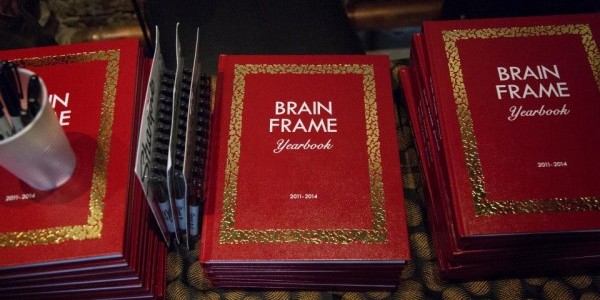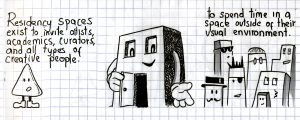Inside Pilsen’s vast Thalia Hall, experimental tunes drifted over anticipatory chatter. Tables were stacked with yearbooks and technicolor zines, and oversized paper mache dog masks topped several heads. It was the final night of Brain Frame, the bi-monthly performative comix series set to end on its 19th run and three-year anniversary.
Opera boxes flanking the stage were transformed into portals of dark whimsy by Brain Frame alumni. Tucked away on the upper left was a video confessional booth. On the right was the chaotic Death Altar. Inside, shredded paper, hectic paint spatters, and a black light showcased a costume of Llama Man; the humanoid monster is the recurring character, childhood nightmare, and “psychopomp” (mediator between the worlds of living and dead, conscious and unconscious) of Brain Frame creator Lyra Hill.

In an adjoining box, an enormous, illuminated brain rocked to and fro. This was the Brain Oracle, receiving audience members’ deepest inquiries — clothespinned correspondences on paper sent from across the room on a pulley high above the stage.
Former Brain Frame interns Emma Rand and Brad Rohloff, sporting football pads, jerseys, and facepaint, hyped an eager audience with high-fives and chest bumps. Near the show’s start they began a chant: “Brain Frame! Brain Frame!” A banner hung across the stage that read “BRAIN FRAME FOREVER.” When the curtain opened, Rand, Rohloff, and current intern Lillie West plowed through the sign in pre-kickoff spirit, leading another cheer as they formed an unlikely human pyramid.

Hill joined the ruckus in overalls and an oversized t-shirt. “I am the placenta from which Brain Frame feeds,” she quipped in her introduction. “So tonight is the night I come out of a vagina and get thrown in the trash…or that someone grinds me up, puts me into pills, and eats me.” Within her charismatic banter lay true sincerity: too many “thank-you’s” to count, glowing appreciation that her family was in town, and a plea for continued collaboration. “I’ve been dealing with a kind of panicked feeling of responsibility towards the community,” Hill admitted in an interview soon after the performance. “I wanted to explicitly state my intention in the last show to inspire and provoke further action, to offer my services as a mentor, advisor, collaborator, or attendee of anything anyone wants to do in this vein.”
Hill began Brain Frame in July of 2011, soon after she performed one of her own comics at a poetry and prose reading series. The positive response she received led her to create her own set of events, reaching out to other creators whose comics lent themselves to the weird and theatrical. “There’s a lot of ego battle embedded in owning oneself as a performer,” says Hill, “so I’d say the moment when I accepted that part of myself and turned it into an active creative part of my life was when I started Brain Frame.” The series flourished, even going on the road a few times to Brooklyn and Detroit.

As artists became more familiar with Brain Frame’s open format, submissions evolved from more straightforward comics and existing pieces to multi-disciplinary works created specifically for the show. Some became a medium all their own. “My work following my involvement has been far more experimental and ambiguous in definition, which I am extremely grateful for,” says West, who, like Rohloff and Rand, was a repeat Brain Frame performer.
The final show embodied the eclecticism that made Brain Frame great. Theater company Rough House kicked off the night with a dream sequence featuring electric use of acting, silhouette, and puppetry. A gender-bending sex scene led to the male protagonist’s pregnancy — his spawn an angry, man-voiced fetus who demands to steal his teeth. A naked game show and a wet bed later, the audience was roaring with applause.

First-time reader Nick Jackson’s poignant comic recalled taking hot tea to political protesters during his stint in Ukraine for the Peace Corps. His words were surrounded by the bittersweet melodies of a bandura, a Ukrainian folk instrument, played live by Motria Caudill. (“Ahhh… talent,” Hill mused before introducing the next act).
Gina Wynbrandt presented an awesomely bawdy coming-of-agecomic. The fictional memoir followed a directionless, Justin Bieber-crazy Wynbrandt who just can’t seem to grow up. Inspired by Sailor Moon, Wynbrandt sought magical powers from a posse of dickish alley cats. Sex, drugs, and rat-eating ensued. A trippy, punk-surrealist tale marked Carrie Vinarsky and Anya Davidson’s Swamped. The pair, clad in club-worthy fur and grime, enacted a hopeless swamp-dwelling couple who stumble upon an all-powerful spirit. Ian McDuffie and Emily Hutchings’ This and Not That used minimal, projected drawings and honest conversation to explore identity, gender fluidity, and owning a body that’s “a symbol of things I am not.”

Hilarious both in concept and ambition, Aaron Reiner and Jessica Campbell’s Sylvia Leeds: The Colonel Throws a Ball offered Agatha Christie-style mystery with an all-dog cast. The production — which explained the paper mache pup heads — featured elaborate projected-illustration sets, prim Clue-style banter, and plenty of canine puns. At its end, the audience woofed and howled in lieu of applause.
In Cat Tongue, Hill captivated like a seasoned veteran. Framed by choppy videos of moving power tools, a center screen held her animated comic of two women in a wood shop discussing masturbation. Hill electronically altered and mixed her voice on the spot, composing a melody of anxiety. Frantic music mirrored animal imagery as the conversation climaxed to its most carnal. Loyal Brain Frame accompanist and Hill’s partner Tyson Torstensen capped off the performances with an elusive composition, leaving vibrations coursing through the crowd’s innards. Hill reappeared for a final speech, and chairs were quickly cleared. It was time for the dance party.
Hill’s Pagan upbringing, steeped in feminism, eco-activism, and collective processes, informed both her collaborative approach to Brain Frame and her own performance practice. She recalls a community that was “emphatically non-hierarchical” and found power in her ability to affect the people around her while reciting invocations. Ritual ties neatly to Hill’s fascination with unconscious urges. In her performances exploring dreams, sexuality, psychedelia, hallucination, and possession, Hill seeks “the feeling of channeling something.”It was important to Hill that the last Brain Frame be a ritual all its own, with the elements of a closing ceremony: homage, altar, a way for participants to actively engage, and an opening and closing of the space.

Brain Frame’s unpretentious atmosphere made for a generous audience, a major confidence booster for artists, many of whom had never previously taken the stage. In return, viewers gained access to creators’ inner worlds. “I’ve always been very interested in the relationship between the artist and their work,” says Hill. “So often it’s obscured or mysterious or withheld out of some purity, and I don’t think that’s interesting. I would rather see all of the mess that it takes to produce an artwork, and I think a performative comix reading explodes the mess.” She notes that the ethos of Brain Frame is in line with a larger shift in the art world favoring openness, experimentation, and group experience over isolated individualism: “We have all these crazy tools, we have all these spaces that are coming and going. Let’s just fuck around and do the weirdest shit we can and have a lot of fun and be real with each other.”

Three years in and hundreds of fans later, why end such a successful endeavor? The decision was partially self-preservation. A perfectionist who never stops raising the bar, Hill had to acknowledge the level of work she was putting into Brain Frame just wasn’t sustainable. More importantly, however, Hill stresses that it’s healthy for things to come to an end — “I don’t ever want anyone to fully know what they’re getting into. There always has to be an element of unease or surprise or danger.” She feared a future where Brain Frame became routine, taken for granted, and, perhaps worst of all, an event where artists repeated themselves.“It’s nice to think that Brain Frame might become like the stuff of legend, a thing that everyone’s heard of but not that many people have been through — a kind of influence behind influence. It has to end to take that position.”

Though Hill anticipated Brain Frame’s end, from the series’ inception she recognized the importance of archiving. She wrote blog post descriptions of each event and posted videos of performances online. For the finale, Hill hoped to offer something more overarching and tangible. She briefly considered a “Best Of” DVD compilation, but was hesitant to name the “best.” “I have always steered away from curating Brain Frame with any form of value judgement,” she explained. “It’s so, so important to the success of Brain Frame that it’s an open, even platform for everybody involved.”
After consulting with numerous Brain Frame participants, the idea of a memory book took shape. By March of this year, a Brain Frame yearbook club was formed. “A yearbook is such an open platform, just like Brain Frame,” says Hill. “It’s celebratory, it’s totally unpretentious, and those were the keys.”

Before the book’s production, Hill and her collaborators distributed audience surveys to gauge topics of interest and acceptable price points. Hill was a bit jarred by the negative response to check-boxes for written content — she chalks it up to her use of the word “essay.” “If you’re going to get a wide range of experience you have to get some writing,” she says, but compromised by soliciting illustrations for every written piece. An act of selfless devotion, each book cost $5 more to print than its sale price.
Such an ephemeral program, where ambiance, sound, and audience participation are critical components, is impossible to fully capture in print format. “What the book ended up being was much more about the people than the performances,” reflects Hill. Each Brain Frame participant from the course of three years is represented by a drawn or photographed portrait of choice. The book announces superlatives like “Most Likely to Injure the Audience,” “Best Vomit,” and “Least Erotic.” A spread called Just Duds journeys through Hill’s flashy mix of Brain Frame costumes. Narrative comics and prose fill the pages with personal experiences and anecdotes of Brain Frame’s past. Torstensen recalls first meeting (and falling for) Hill. Hill includes illustrated testimony about losing and finding herself and the people who helped along the way.

The yearbook was a hit. At Brain Frame 19, performers, former participants, and spectators old and new clenched the books to their chests with juvenile enthusiasm. We passed them back and forth, penning blank pages with signatures, memories, cartoons, and well-wishes.
The spirit of Brain Frame promises to live on through those who witnessed and performed it. Rand, who was Brain Frame’s longest-running intern, is now the Student Services Director of Chicago’s new Scuola Internazionale di Comics (International School of Comics).“I have made so many friends and contacts who will soon be friends that I hope never to lose,” she says. “I hope that one day there might be a reunion show several years from now, but who knows?” Rohloff has started his own indie press, Bred Press. “Everyone and everything that Brain Frame touched was inspired by it, and I think the community understands and now practices its message that anything is possible,” says West. “I anticipate events of similar caliber all over the place, by myself and everyone else.”

Hill carries on Brain Frame’s collaborative essence as co-Lead Artist of the Teen Creative Agency for the MCA Chicago. The group’s mission statement is “Building community and building community builders,” and the artist is often consulted for her experience organizing Brain Frame. The TCA even performed a Brain Frame event of their own earlier this year.
As for personal projects, Hill already has some plans she’s aching to dive into. She intends to perform Cat Tongue as part of a trilogy about oral fixations and female sexuality. She’s also collaborating with Torstensen on a nightmarescape experience called Dream Home — the pair performed an excerpt at Brain Frame 13 last year. They hope to create a dual release comic book and LP in a gatefold record sleeve. Llama Man, Hill assures, is set to participate. “He’s perfect for the role,” she smirks. “He’s ageless.”
The day after the final Brain Frame, Torstensen, Hill’s mother, godmother, brother, and sister performed a special ritual to help Hill say goodbye. Each stood at a point on her body that represented a stage of life — birth, initiation, fertility, repose, and death — and spoke words of comfort relating to each. “The intention was to help me know that the cycle is complete for Brain Frame, and it’s just beginning for other things in my life. I’m at all of the different points right now in different aspects of my life. … It was just feeling loved, being loved, and being reminded of what I had accomplished — why it was over, why it was good, and all of the places I had left to go. It’s really a gift.”
 Sierra Nicole Rhoden is a writer and illustrator who lives in Chicago. She graduated last year from the School of the Art Institute of Chicago with an M.A. in New Arts Journalism. She is the assistant director of Josef Glimer Gallery and paints monthly portraits for the Chicago Tribune. Her writing has appeared previously in Sixty Inches From Center, F-newsmagazine, Ink Well, and EXPO Chicago’s blog The Seen. You can check out her work at sierranikki.com.
Sierra Nicole Rhoden is a writer and illustrator who lives in Chicago. She graduated last year from the School of the Art Institute of Chicago with an M.A. in New Arts Journalism. She is the assistant director of Josef Glimer Gallery and paints monthly portraits for the Chicago Tribune. Her writing has appeared previously in Sixty Inches From Center, F-newsmagazine, Ink Well, and EXPO Chicago’s blog The Seen. You can check out her work at sierranikki.com.



